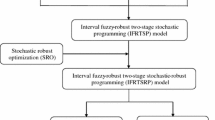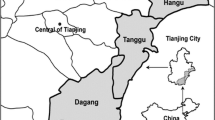Abstract
This paper presents an interval-parameter two-stage stochastic fuzzy programming with type-2 membership functions (ITSFP–T2MF) approach for supporting water resources management under uncertainty. ITSFP–T2MF is capable not only of dealing with a variety of uncertainties expressed as probability distributions, intervals, and type-2 fuzzy sets, but also of reflecting the complexity of uncertainty presented as the concept of a flexible fuzzy decision. A scenario-based solution method is proposed for solving ITSFP–T2MF, which takes into account different attitudes of decision makers (DMs) towards the objective-function value and constraints. Moreover, the solution method can ensure that no infeasible solutions are included in the results by means of a feasibility test and a constricting algorithm, leading to an enhanced system safety. ITSFP–T2MF is applied to a case study of water resources allocation under uncertainty. The results indicate that interval solutions can be obtained under different scenarios, which enhances the diversity of solutions for supporting the decisions of water resources allocation. Furthermore, a variety of decision alternatives can be generated under different policies for water resources management, which permits an in-depth policy analysis associated with different levels of economic penalties when the promised water-allocation targets are violated, and thus helps DMs identify desired water-allocation plans according to practical situations.








Similar content being viewed by others
References
Birge JR, Louveaux FV (1988) A multicut algorithm for two-stage stochastic linear programs. Eur J Oper Res 34:384–392
Cao MF, Huang GH (2011) Scenario-based methods for interval linear programming problems. J Environ Inform 17:65–74
Cao MF, Huang GH, Sun Y, Xu Y, Yao Y (2010) Dual inexact fuzzy chance-constrained programming for planning waste management systems. Stoch Env Res Risk Assess 24:1163–1174
Chang NB, Wang SF (1997) A fuzzy goal programming approach for the optimal planning of metropolitan solid waste management systems. Eur J Oper Res 99:303–321
Faybishenko B (2010) Fuzzy-probabilisitc calculations of water-balance uncertainty. Stoch Env Res Risk Assess 24:939–952
Huang GH (1998) A hybrid inexact-stochastic water management model. Eur J Oper Res 107:137–158
Huang GH, Cao MF (2011) Analysis of solutions methods for interval linear programming. J Environ Inform 17:54–64
Huang GH, Loucks DP (2000) An inexact two-stage stochastic programming model for water resources management under uncertainty. Civil Eng Environ Syst 17:95–118
Huang GH, Baetz BW, Patry GG (1992) A grey linear programming approach for municipal solid waste management planning under uncertainty. Civil Eng Environ Syst 9:319–335
Jairaj PG, Vedula S (2000) Multireservoir system optimization using fuzzy mathematical programming. Water Resour Manage 14:457–472
Kentel E, Aral MM (2005) 2D Monte Carlo versus 2D fuzzy Monte Carlo health risk assessment. Stoch Environ Res Risk Assess 19:86–96
Li YP, Huang GH, Huang YF, Zhou HD (2009) A multistage fuzzy-stochastic programming model for supporting sustainable water-resources allocation and management. Environ Model Softw 24:786–797
Li YP, Huang GH, Guo P, Yang ZF, Nie SL (2010) A dual-interval vertex analysis method and its application to environmental decision making under uncertainty. Eur J Oper Res 200:536–550
Maqsood I, Huang GH, Yeomans JS (2005) An interval-parameter fuzzy two-stage stochastic program for water resources management under uncertainty. Eur J Oper Res 167:208–225
Pereira MVF, Pinto LMVG (1991) Multi-stage stochastic optimization applied to energy planning. Math Program 52:359–375
Qin XS (2012) Assessing environmental risks through fuzzy parameterized probabilistic analysis. Stoch Environ Res Risk Assess 26:43–58
Qin XS, Huang GH, Zeng GM, Chakma A, Huang YF (2007) An linear-parameter fuzzy nonlinear optimization model for stream water quality management under uncertainty. Eur J Oper Res 180:1331–1357
Seifi A, Hipel KW (2001) Interior-point method for reservoir operation with stochastic inflows. ASCE J Water Resour Plan Manage 127:48–57
Slowinski R (1986) A multicriteria fuzzy linear programming method for water supply system development planning. Fuzzy Sets Syst 19:217–237
Tesfamariam S, Sadiq R (2006) Risk-based environmental decision-making using fuzzy analytic hierarchy process (F-AHP). Stoch Environ Res Risk Assess 21:35–50
Wang S, Huang GH (2011) Interactive two-stage stochastic fuzzy programming for water resources management. J Environ Manage 92:1986–1995
Wang S, Huang GH, Lu HW, Li YP (2011) An interval-valued fuzzy linear programming with infinite α-cuts method for environmental management under uncertainty. Stoch Environ Res Risk Assess 25:211–222
Wang S, Huang GH, Yang BT (2012) An interval-valued fuzzy-stochastic programming approach and its application to municipal solid waste management. Environ Model Softw 29:24–36
Watkins DW Jr, McKinney DC, Lasdon LS, Nielsen SS, Martin QW (2000) A scenario-based stochastic programming model for water supplies from the highland lakes. Int Trans Oper Res 7:211–230
Zadeh LA (1975) The concept of a linguistic variable and its application to approximate reasoning—I. Inf Sci 8:199–249
Zimmermann HJ (1985) Applications of fuzzy set theory to mathematical programming. Inf Sci 36:29–58
Acknowledgments
This research was supported by the Major Project Program of the Natural Sciences Foundation (51190095), the Natural Science and Engineering Research Council of Canada, the Program for Innovative Research Team (IRT1127), and the MOE Key Project Program (311013). The authors would like to express thanks to the editor and the anonymous reviewers for their constructive comments and suggestions.
Author information
Authors and Affiliations
Corresponding author
Appendix: Solution method
Appendix: Solution method
A scenario-based solution method is proposed for solving the ITSFP–T2MF model, which takes into account six scenarios that represent different attitudes of DMs towards the objective-function value and constraints. Besides, the solution method can guarantee the feasibility of the generated interval solutions by means of a feasibility test and a constricting algorithm. The detailed solution procedures for solving ITSFP–T2MF are shown as follows.
1.1 Scenario 1
Step 1. Solve the following two deterministic submodels, respectively.
Submodel (A1):
subject to:
Submodel (A2):
subject to:
where \( f_{\text{opt}}^{ + } \), \( S_{{ij{\text{opt}}}}^{ - } \), and \( y_{{i{\text{opt}}}} \) are solutions of submodel (A1); \( f_{\text{opt}}^{ - } \) and \( S_{{ij{\text{opt}}}}^{ + } \) are solutions of submodel (A2). Interval solutions of \( f_{\text{opt}}^{ \pm } = [f_{\text{opt}}^{ - } ,f_{\text{opt}}^{ + } ] \) and \( S_{{ij{\text{opt}}}}^{ \pm } = [S_{{ij{\text{opt}}}}^{ - } ,S_{{ij{\text{opt}}}}^{ + } ] \) can thus be obtained through solving submodels (A1) and (A2).
Step 2. Conduct the feasibility test. If pass, then stop. Otherwise, go to step 3.
Step 3. Apply the constricting algorithm to eliminate infeasible solutions.
1.2 Scenario 2
Step 1. Different from scenario 1, constraints (A1c) in submodel (A1) and constraints (A2c) in submodel (A2) can be respectively converted into the following two inequalities:
Step 2. Conduct the feasibility test. If pass, then stop. Otherwise, go to step 3.
Step 3. Apply the constricting algorithm to eliminate infeasible solutions.
1.3 Scenario 3
Step 1. Solve the following two deterministic submodels, respectively.
Submodel (A5):
subject to:
Submodel (A6):
subject to:
where \( f_{\text{opt}}^{ - } \), \( S_{{ij{\text{opt}}}}^{ + } \), and \( y_{{i{\text{opt}}}} \) are solutions of submodel (A5); \( f_{\text{opt}}^{ + } \) and \( S_{{ij{\text{opt}}}}^{ - } \) are solutions of submodel (A6). Interval solutions of \( f_{\text{opt}}^{ \pm } = [f_{\text{opt}}^{ - } ,f_{\text{opt}}^{ + } ] \) and \( S_{{ij{\text{opt}}}}^{ \pm } = [S_{{ij{\text{opt}}}}^{ - } ,S_{{ij{\text{opt}}}}^{ + } ] \) can thus be obtained through solving submodels (A5) and (A6).
Step 2. Conduct the feasibility test. If pass, then stop. Otherwise, go to step 3.
Step 3. Apply the constricting algorithm to eliminate infeasible solutions.
1.4 Scenario 4
Step 1. Different from scenario 3, constraints (A5c) in submodel (A5) and constraints (A6c) in submodel (A6) can be respectively converted into the following two inequalities:
Step 2. Conduct the feasibility test. If pass, then stop. Otherwise, go to step 3.
Step 3. Apply the constricting algorithm to eliminate infeasible solutions.
1.5 Scenario 5
Step 1. Firstly, solve the following submodel (A9) in which all interval parameters can be converted into their mid-values. Then, solve the submodels (A10) and (A11), respectively.
Submodel (A9):
subject to:
Submodel (A10):
subject to:
Submodel (A11):
subject to:
where \( S_{ij}^{\text{m}} \) are solutions of submodel (A9); \( f_{\text{opt}}^{ + } \), \( S_{{ij{\text{opt}}}}^{ - } \), and \( y_{{i{\text{opt}}}} \) are solutions of submodel (A10); \( f_{\text{opt}}^{ - } \) and \( S_{{ij{\text{opt}}}}^{ + } \) are solutions of submodel (A11). Interval solutions of \( f_{\text{opt}}^{ \pm } = [f_{\text{opt}}^{ - } ,f_{\text{opt}}^{ + } ] \) and \( S_{{ij{\text{opt}}}}^{ \pm } = [S_{{ij{\text{opt}}}}^{ - } ,S_{{ij{\text{opt}}}}^{ + } ] \) can thus be obtained through solving submodels (A9), (A10), and (A11).
Step 2. Conduct the feasibility test. If pass, then stop. Otherwise, go to step 3.
Step 3. Apply the constricting algorithm to eliminate infeasible solutions.
1.6 Scenario 6
Step 1. Different from scenario 5, constraints (A10c) in submodel (A10) and constraints (A11c) in submodel (A11) can be respectively converted into the following two inequalities:
Step 2. Conduct the feasibility test. If pass, then stop. Otherwise, go to step 3.
Step 3. Apply the constricting algorithm to eliminate infeasible solutions.
Rights and permissions
About this article
Cite this article
Wang, S., Huang, G.H. An interval-parameter two-stage stochastic fuzzy program with type-2 membership functions: an application to water resources management. Stoch Environ Res Risk Assess 27, 1493–1506 (2013). https://doi.org/10.1007/s00477-013-0685-2
Published:
Issue Date:
DOI: https://doi.org/10.1007/s00477-013-0685-2




